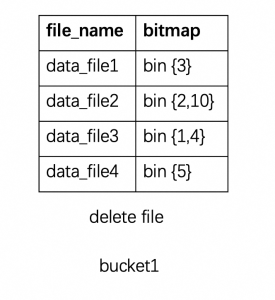Paimon Deletion Vector
deletion vector 是通过一组向量, 维护一个文件中被删除的行, 可以理解为一种索引. 这种方式可以以 Merge On Write 的方式, 来避免 Merge On Read 的过程, 从而以写入性能换取读取性能. 对于写少读多, 或者对读取性能有更高要求的场景会比较适合.
避免 Merge On Read 会带来以下几个好处:
- 读取时仅需要直接读取文件, 并根据 bitmap 跳过对应的删除行即可, 跳过 Merge 过程, 直观的提升读取效率
- 和 Native 引擎结合更好, 可以通过 C++ reader, 直接读取文件并进行向量过滤, 避免了通过 jni 的 merge 过程
- 由于不再需要 merge, 因此 split 切分可以更细, 从而增多 split, 提升读取的并发度
- 可以进行 value 字段的 filter push down, 从而实现更好的过滤效果.
- 因为在 MOR 的情况下, 由于存在多个 Key value 需要合并的情况, 因此在合并之前不能进行 value filter 下推.
写入/compaction 过程
LookupChangelogMergeFunctionWrapper
deletion vector 的创建依赖于 compaction. 在 compaction 过程中通过 lookup 查找高层文件, 并进行文件删除行的标记.
开启 delete vector 后, 会强制进行 Lookup, 从而使用 ForceUpLevel0Compaction 的 Compaction 策略.
org.apache.paimon.operation.KeyValueFileStoreWrite#createRewriter
// 对于needLookup的场景, 采用ForceUpLevel0 compaction的机制
CompactStrategy compactStrategy =
options.needLookup()
? new ForceUpLevel0Compaction(universalCompaction)
: universalCompaction;
processor =
lookupStrategy.deletionVector
? new PositionedKeyValueProcessor(
valueType,
lookupStrategy.produceChangelog
|| mergeEngine != DEDUPLICATE
|| !options.sequenceField().isEmpty())
: new KeyValueProcessor(valueType);
这里的 processor 对应于 lookup 过程中如何处理 value 字段, 首先对于 deletion vector 场景, 我们查找到一个 key 时, 需要知道对应的"行号" position, 因此需要 PositionedKeyValueProcessor 即记录对应 KV pair 的行号.
其次对于以下三种场景, 还要求 lookup 的过程中, 读取完整的 value
lookupStrategy.produceChangelog由于要产生 Changelog, 所以需要知道前值, 因此需要完整的 value 读取mergeEngine != DEDUPLICATE!options.sequenceField().isEmpty()和上面的一样, 这几类场景都是基于 L0 key 查找到高层值的时候, 不能简单的将高层标记为delete, 而是需要执行一次 Merge 过程, 例如 Partial-Update, 或者根据 sequence field 比较后才 deduplicate, 所以这几类也需要读取完整value.
如果不是这几类, 比如不带排序字段的 deduplicate, 那么在 lookup 的过程中, 只需要读取对应的 key 即可, 那么就可以大大降低 lookup 的 IO 开销.
DeletionVectorsMaintainer
Lookup 过程中, 对于查找到高层的 key, 可以对高层数据标记删除. DeletionVectorsMaintainer 中维护了文件到 DeletionVector 的映射, DeletionVector 的实现通常是一个 RoaringBitmap.
if (lookupResult != null) {
if (lookupStrategy.deletionVector) {
PositionedKeyValue positionedKeyValue = (PositionedKeyValue) lookupResult;
highLevel = positionedKeyValue.keyValue();
deletionVectorsMaintainer.notifyNewDeletion(
positionedKeyValue.fileName(), positionedKeyValue.rowPosition());
} else {
highLevel = (KeyValue) lookupResult;
}
}
按照 pip-16 中的描述, 每个 bucket 会维护一个 delete vector 文件 , 这个文件中维护了所有有删除 key 的文件和对应的 bitmap.

- 同步生成: 在 Compaction 完成后, 将内存中维护的 Map<String, DeletionVector> 数据结构写入对应的 index 文件. 这块其实会在内存里面维护每个有删除行为的文件的 deletion vector. 启动阶段也会从元数据中读取恢复. 当文件比较多的时候, 这块的内存开销可能也不容忽视. 而且由于 Map 维护, 只要有一个文件更新, 整个 index 文件也是要被重写的.
- 异步生成: delete vector 生成也支持异步化, 这样就可以不阻塞主链路的写入流程.
查询/读取
RawSplitRead
KeyValueTableRead
this.readProviders =
Arrays.asList(
new RawFileSplitReadProvider(batchRawReadSupplier, this::assignValues),
new MergeFileSplitReadProvider(mergeReadSupplier, this::assignValues),
new IncrementalChangelogReadProvider(mergeReadSupplier, this::assignValues),
new IncrementalDiffReadProvider(mergeReadSupplier, this::assignValues));
对于 KeyValueTableRead, 会创建一堆的 SplitReadProvider, 哪个 match 就走哪个读取.
public boolean match(DataSplit split, boolean forceKeepDelete) {
boolean matched = !forceKeepDelete && !split.isStreaming() && split.rawConvertible();
if (matched) {
// for legacy version, we are not sure if there are delete rows, but in order to be
// compatible with the query acceleration of the OLAP engine, we have generated raw
// files.
// Here, for the sake of correctness, we still need to perform drop delete filtering.
for (DataFileMeta file : split.dataFiles()) {
if (!file.deleteRowCount().isPresent()) {
return false;
}
}
}
return matched;
}
- 对于 dv 表, 他的 split 是
rawConvertible的, 即表示对应的 reader 可以转化为 raw reader.
ApplyDeletionFileRecordIterator
public InternalRow next() throws IOException {
while (true) {
InternalRow next = iterator.next();
if (next == null) {
return null;
}
if (!deletionVector.isDeleted(returnedPosition())) {
return next;
}
}
}
真正的读取过程, 就是根据提前加载的 delete vector 根据行号进行过滤.
还有一些其他关于读取的改动, 主要是 filter 下推相关的. 因为当文件可以 raw read, 不需要合并后, 非主键字段也就可以安全下推了.
例如: 开启 dv 的表, 可以应用其他的 value filter, 因此也就可以使用索引机制了.
Append Table DV support
除此之外, Paimon 还利用 deletion vector 实现了对 Append 表的删除
append 表的删除可以类比 iceberg 的实现, 根据输入数据, 构建删除的 deletion vector, 从而实现 append 表的删除逻辑.
if (deletionVectorsEnabled) {
// Step2: collect all the deletion vectors that marks the deleted rows.
val deletionVectors = collectDeletionVectors(
candidateDataSplits,
dataFilePathToMeta,
condition,
relation,
sparkSession)
deletionVectors.cache()
try {
// Step3: write these updated data
val touchedDataSplits = deletionVectors.collect().map {
SparkDeletionVectors.toDataSplit(_, root, pathFactory, dataFilePathToMeta)
}
val addCommitMessage = writeOnlyUpdatedData(sparkSession, touchedDataSplits)
// Step4: write these deletion vectors.
val indexCommitMsg = writer.persistDeletionVectors(deletionVectors)
addCommitMessage ++ indexCommitMsg
} finally {
deletionVectors.unpersist()
}
} else {
- 通过 filter 过滤, 先拿到 update 或 delete 语句可能影响的 split
- 构建 Reader 读取, 读取的 plan 额外添加 Metadata column,
__paimon_file_path和__paimon_row_index, 这两个是上面 deletion vector 构建的依赖元信息 - 根据
update输入构建 deletion vector (indexCommitMsg), 根据update输出构建addCommitMsg
本文来自博客园,作者:Aitozi,转载请注明原文链接:https://www.cnblogs.com/Aitozi/p/18551580



 浙公网安备 33010602011771号
浙公网安备 33010602011771号